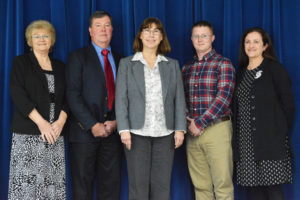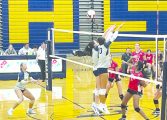Kids ask for a later school-day start
By Ruthann Carr, Correspondent
After hearing three students implore them for a later school-day start, the Fluvanna County School Board heard about continuous improvement plans and 2020 budget considerations.
The board held a seminar Tuesday (Oct. 30) to get a jump start on planning the next budget; however, only three were present: Chair Perrie Johnson (Fork Union), Vice Chair Brenda Pace (Palmyra) and Shirley Stewart (Rivanna).
Charles Rittenhouse (Cunningham) and Andrew Pullen (Columbia) had work commitments.
 During opening public comments, Samuel Guseman, a Fluvanna Middle School fifth grader, suggested school should run from 9:30 a.m. to 4:30 p.m. instead of 7:45 a.m. to 2:45 p.m.
During opening public comments, Samuel Guseman, a Fluvanna Middle School fifth grader, suggested school should run from 9:30 a.m. to 4:30 p.m. instead of 7:45 a.m. to 2:45 p.m.
“I don’t think school should start this early because kids are not getting enough sleep,” he said. “A sleep doctor came to my health class and said that kids my age need to get at least 10 hours of sleep. I only get around seven” due to difficulty falling asleep.
His sister, Anneliese Guseman, suggested the same hours.
“Once, I almost got sick because I was so tired,” she said. “Sometimes my classmates fall asleep in class.”
Anneliese gave the board a copy of her presentation which included a list of her classmates who agreed with her proposal. Fifteen students agreed and two did not.
Their brother, Anthony Guseman, who is in seventh grade, suggested the same, later hours.
Absenteeism
Director of Finance and Instruction Brenda Gilliam told the board state standards of accreditation now includes chronic absenteeism as a variable.
“The state considers 10 percent or more days missing from school as chronically absent. That’s about 17 days,” she said.
The state goal for elementary and middle schools is to have less than 15 percent chronic absenteeism.
In the 2017-18 school year, Fluvanna’s elementary rate was 15.13 percent and the middle school was 18.6 percent.
The goal for high schools is less than 24 percent. Fluvanna’s was 25.95 percent.
Lower elementary
Central and West Central Primary Principal Amy Barnabei said one of her goals is to make sure every student has access to the Science Technology Engineering Arts Math (STEAM) lab.
“We looked at the numbers and saw it was the same kids using those services – the high achieving students,” she said. “We want to encourage all students, even those who may not be doing well – to use them.”
She said it’s well known that some children may struggle in conventional classrooms but might be reached in a STEAM lab because they are hands-on learners.
Upper elementary
Carysbrook Principal Scott Lucas said he encourages a collaborative teaching environment and, to that end, he took several fourth grade teachers to a school last year that does it well. This year he will take third grade teachers.
Lucas praised the B.E.S.T. (behavior, educational, socio-emotional, teaching) Lab initiated last year. It helps students before they get to the point of suspendable behavior.
“It truly isn’t a glorified ISS [in-school suspension]. It’s educational. It’s a break. We’ve seen a huge decrease in discipline referrals,” Lucas said. “We’re trying to nip it in the bud before it gets to that.”
Superintendent Chuck Winkler asked Lucas about teacher goals – particularly the goal of 80 percent of students reaching typical growth.
Lucas said that goal may have been a reach.
“When I look at typical growth, I want 90 percent of my kids to achieve typical growth – 50 percent is the standard,” he said.
“Part of a smart goal is, is it reasonable? We’ll re-evaluate mid-year.”
Stewart asked Lucas how often teachers say an impediment to student growth is lack of resources.
Lucas said that is rarely mentioned. Mentioned most often are inattentiveness, attendance and what may be going on at home.
Middle school
Middle school Principal Bradley Stang said when he talked to his staff before the school year began, he talked about them being on a journey. “And a journey is a process,” he said.
He said many teachers are concerned about Standards of Learning and Methods of Academic Progress scores.
“I tell them, ‘Don’t worry about it; just teach.’ The only person who’s going to lose their job for low scores is me,” Stang said.
Stang said he focuses on the cultural climate for his students as much as the learning environment. “If we don’t get the social-emotional piece right the rest won’t follow,” he said.
High school
High school Principal Margo Bruce said the theme for her teachers and staff is “getting better.”
Bruce does regular wellness checks with new teachers just to see how they’re doing.
To deal with suspensions, Bruce instituted a minimum of three silent lunches before in-school suspension for a full day.
All principals talked about teachers taking a leading role in contacting parents about a student’s absence. Bruce has an attendance committee and created a fact sheet “so parents know an excused absence is the same as non-excused,” she said.
“They’re not there, so they’re not learning.”
Budget
Winkler and Gilliam spent the rest of the seminar talking about 2020 budget considerations. They said enrollment affects funding and projected enrollment for 2020 is 3,453, down from the 2019 projection of 3,460.
Among budget considerations, Winkler listed a 3 percent raise for teachers, increased staffing, keeping small class sizes, adding field hockey, increasing special education support and raising pay for support staff.
Other potential budget additions:
Substitute teacher/nurse pay: $100,000;
Compensation for team leaders: $40,000;
Dedicated homebound teacher: $70,000;
Increased funding for instructional supplies and textbooks: $70 per student and $10 per student library books;
Early childhood special education and Virginia Preschool Initiative Program student numbers increasing;
Middle school agriculture start-up: $20,000 to $100,000 plus a teacher; and
Mental health support.




